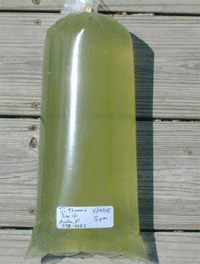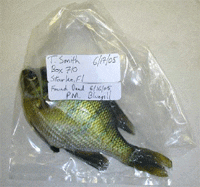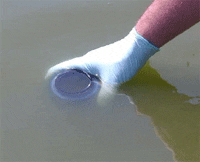Such an event can be very upsetting because it may represent a substantial economic or emotional loss, and because it is often unexpected it can be a shock. A catastrophic fish kill is one in which one hundred percent (or very close to it) of the population dies suddenly and within a short period of time (i.e. <24 hours). A typical history may be that the fish looked fine the previous night, and ate normally, but were all dead in the morning. This type of history is almost always indicative of environmental disease.
There are a number of different causes of environmental disease and catastrophic mortality. The most common cause of a sudden and catastrophic fish kill is low dissolved oxygen. This topic is discussed in detail in IFAS extension fact sheet number FA-27. Other “natural” causes of catastrophic mortality include toxic ammonia, nitrite, and hydrogen sulfide. Water chemistry is extremely complex and it is naïve to immediately rule out a “natural” phenomenon as a cause of a catastrophic fish kill. It is not uncommon for people to jump to the conclusion that the fish were “poisoned”-either by malicious intent, or by accident. However, if there is no direct evidence of a toxin being introduced into the water, it is prudent to remember that most fish kills with this type of history are caused by water quality problems and not by the introduction of exogenous toxins.
Steps to Follow if a Catastrophic Fish Kill Occurs
When responding to a catastrophic fish kill, whether you are the owner or are assisting the owner, there are five basic steps to follow:
- Collection of a water sample
- Collection of a fish sample
- Collection of a sediment sample
- Documentation
- Notification of authorities, if appropriate.
These steps have been summarized in the Reference Guide for Fish Kill Investigations for quick reference.
Collect a Water Sample

When a catastrophic fish kill is discovered, the first step many people take is to immediately begin flushing the system with fresh water. It is important that regardless of the cause, a water sample should be collected before fresh water is introduced. If the system is flushed without collecting a water sample it may be impossible ever to determine the cause of the problem. If an oxygen meter is available, an oxygen reading should be taken-both at the surface and at depth.
The time of day should be recorded as well as the dissolved oxygen concentration and water temperature. If an oxygen meter is not available, then the water sample should be collected and capped under the surface, with no air bubbles present in the sealed sample. It is best to collect at least three water samples if a toxin is suspected. One can be analyzed immediately by a fish disease laboratory for routine water quality anomalies.
The other two samples can be frozen for possible future analysis if a specific toxin is identified as a potential cause. Samples should be collected using inert wide-mouth plastic containers or sturdy plastic bags. They should be well labeled (Figure 1). Remember that glass containers filled with water will break when frozen. If there is a possibility that any fish are still alive in the system it is appropriate to begin to flush as soon as these water samples have been collected. It may also be advisable to turn on aeration equipment.
Collect a Fish Sample

In addition to collection of a water sample it is also important to collect a fish sample, both for routine diagnostic evaluation and for detection of a suspect toxin if one is identified. When collecting fish for analysis, remember that a fish that has died and floated to the surface is a poor sample, and usually will be discarded by the receiving laboratory. The best sample is a fish that is still alive and showing clinical signs of distress (i.e. gasping, hanging at the surface, swimming in circles etc.). If live fish are not available, it is possible to assess carcasses for deterioration. A carcass that may have some diagnostic value will not smell awful (yet), the gills should still have some red color, and the eyes should be clear rather than opaque.
When collecting fish for analysis at least six animals should be taken. Each one can be placed in a sealed plastic bag labeled with the date, site and contents (Figure 2). Three fish should be placed on ice (not frozen) and submitted immediately to a fish disease diagnostic laboratory for routine evaluation. This is an important step to document whether or not a disease agent could have caused or contributed to the loss.
The importance of this step cannot be overemphasized. The remaining three fish should be frozen along with two of the three water samples that have already been collected and labeled. These will be used, if a toxin is identified, to test fish tissue for the presence of the suspected compound.
Collect a Sample of Sediment
In addition to fish and water samples, a sediment sample should also be taken. At least three plastic bags or bottles of sediment should be labeled and frozen. Samples of sediment should be collected from at least three sites in the affected pond. Sediment samples can be collected with a can attached to a long pole. Only the top six inches of sediment should be sampled. The labeled samples should be frozen with the fish and water samples previously collected. If a toxin is eventually identified these can be tested for the presence of the suspect compound.
Document Everything

In addition to collection of the samples described above, it is important to document everything that transpired as it may be relevant to the fish kill. This is particularly important if there is a chance, no matter how small, that litigation may be pursued to try to collect for damages or losses incurred. If possible, one or more witnesses should be called upon to substantiate all observation. Data collected should include historical data on the affected pond (i.e. stocking date, number of animals present, species present). The number of mortalities that occurred should be accurately documented (count them!) and the date or dates on which the fish kill was observed should be recorded. Photographs should be taken and dated to document the event. Observations should be written down, dated and signed. Witnesses should be asked to write their observations down, date the paper, and sign it.
If anyone has been observed spraying a potentially toxic compound in the vicinity of the affected pond, it is important to include any available information in the written record. This might include the make and model of a vehicle, as well as tag identification, the name of the company doing the spraying if it is known, and most importantly, the identification of the compound that has been sprayed. It is important to be polite, but firm, when seeking information. Most companies that spray chemicals are very careful about avoiding “drift,” which means that they are careful to minimize spraying when weather conditions may enhance the potential for chemical to drift away form the intended target area. If a sprayer is uncooperative, and refuses to tell you what has been sprayed, the next best thing is to try to determine what was being targeted (i.e. a particular crop or a weed or animal pest around a home). Specific information on the target will help make it possible to “guess” what the compound was. It is usually cost prohibitive to test samples for a “suspect toxin” unless the likely compound is known. Assays need to be run for specific, identified compounds. Examples might include organophosphates, organochlorines, or copper.
Notification of Authorities
If a potentially toxic compound is suspected to have been applied near a pond, the Bureau of Pesticide Compliance, Florida Department of Agriculture and Consumer Services, should be contacted at 850-488-3314.
Summary
Anytime a catastrophic fish kill occurs it is a cause of distress to the owners. Substantial financial or emotional loss may be incurred. Most catastrophic fish kills are caused by environmental problems, with low dissolved oxygen being the most common. On rare occasions a toxin may be introduced to a pond, either by accident or by malicious intent. It is important to follow a standard procedure to determine the cause of the fish kill and to collect the necessary documentation if there is a possibility of legal action. First, water samples must be collected before flushing the system. Routine water analysis (dissolved oxygen, total ammonia, nitrite, pH, total alkalinity and total hardness) should be run and additional samples should be frozen for possible later analysis if a specific toxin is identified. Fish should be collected and divided into two groups; one for routine diagnostic evaluation and a second group should be frozen. Sediment samples should also be frozen. The fish kill should be thoroughly documented, photographed, and witnesses should be asked to sign a statement describing the details of the event in the context of their personal observations.
Reference Guide for Fish Kill Investigations
-
Using wide-mouth clean plastic jars or sturdy plastic bags, collect three separate water samples. Jars or bags must be sealed while held under water surface to avoid trapping air bubbles (Figure 3). One water sample should be placed on ice for routine water testing, and the other two frozen. All water samples must be labeled with pond owner's name, location, and date and time of collection.
-
Six live fish showing signs of distress should be collected. If live fish are not available, six fresh dead fish should be collected. Three live fish should be placed in a bucket or large bag of pond water and immediately taken to a diagnostic laboratory for examination. The fish should not be exposed to temperature extremes during transport to the laboratory. If the fish are dead, they should be placed on ice and rushed to the laboratory. The fish should be accompanied by an information sheet containing pond owner's name, location, and date and time of collection. The other three fish should be labeled with the appropriate information and frozen.
-
Three samples of sediment should be collected, labeled with pond owner's name, location, and date and time of collection, and frozen.
-
Everything related to the fish kill should be documented. Photographs should be labeled, and if witnesses are available, their signed statements should be collected.
-
If a toxin spray or runoff is suspected, contact the Florida Department of Agriculture and Consumer Services, Bureau of Pesticide Compliance at 850-488-3114.
November 2008

